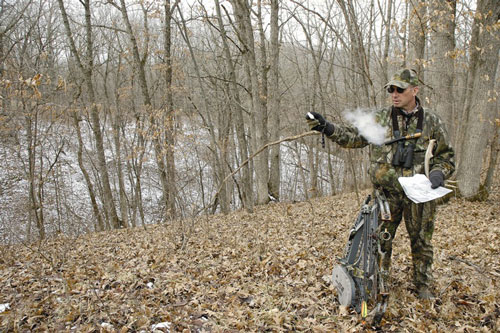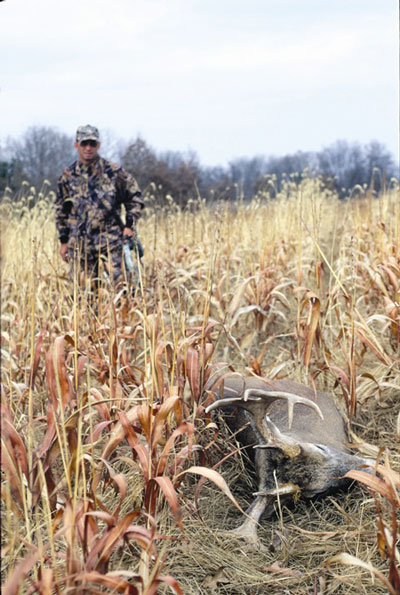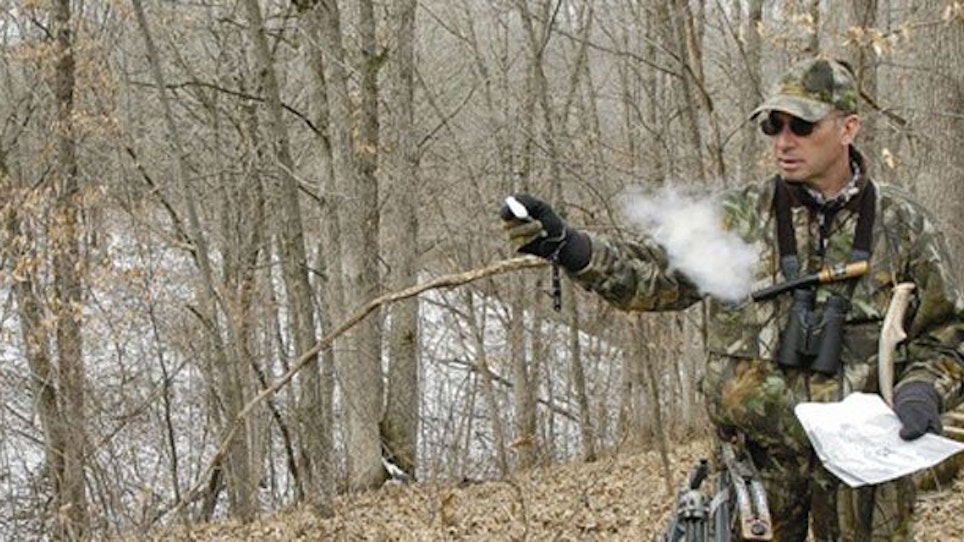Previously: Overcoming Wind, How Deer Use Ridges
Ridgetop Patterns
 Besides the sidehill trails, which are the easiest ridge pattern to find and hunt, here are three more patterns you should look for when hunting rugged country.
Besides the sidehill trails, which are the easiest ridge pattern to find and hunt, here are three more patterns you should look for when hunting rugged country.
Ridge Crossings: For nearly half a mile the ridgetop was open, save for one narrow finger of timber that crossed over the top and joined the two sides. It was a natural, low-profile crossing point for deer traveling from one sidehill timber to the other. My stand was on the downwind side of the ridgetop where I could cover the two trails deer followed when moving along this wooded, ridge-crossing strip. Also within range, but slightly below me on the hill, was the heavily used side trail. I felt like I was in position to get a shot at nearly every deer that traveled the ridge.
A nice 10-pointer followed the strip of cover over the ridge and right to my stand an hour before sunset. At 18 yards, he stopped to freshen a scrape, and moments later, when he turned, I had my payoff for the long hours. The following year, while hunting an identical setup, I took a dandy 8-pointer.
This pattern is the best you can find when hunting ridgetops. Here’s how to set up: First, find a structure that goes over the ridgetop and connects the two sidehills, usually a brushy fence line or strip of timber—the perfect travel corridor for a buck trying to keep a low profile.
Without a doubt, there will be a deer trail on each side of the structure. Make sure you can cover both from your stand. Now move down the sidehill on the prevailing downwind side. You should come across the edge or sidehill trail. Find a tree that allows you to keep all three of these trails within bow range.
If you can’t find a fenceline or an unbroken band of cover that connects both sides of an open ridgetop, look for fingers of timber extending toward each other from opposite sides. Even though they don’t offer complete concealment for a traveling buck, the fingers do hide him for a portion of the crossing. He’ll take advantage of that, and so should you.
Access this ridge stand by coming in from below, straight up the hill into the wind, or you will pollute too much country with your scent.
Ditches: Ditch crossings are easy to find, easy to hunt, and produce good action. Anytime there’s a slope there’s bound to be run-off and erosion. Some of the erosion ditches are so deep and/or steep that deer don’t cross them unless pushed. This sets up the perfect scenario for funneling.
Deer are much more likely to go around such a ditch than to cross it, meaning the upper end and the lower end are natural hotspots that nearly every deer using the sidehill will have to pass through. It’s tough to hunt down in the bottom of a draw, so this basically eliminates the lower end of the ditch, leaving only one choice—the top. But it’s a very good choice. Ditches usually form between two side ridges where does often bed. During the rut, bucks will trade between these places, making the ditch funnel a natural hotspot.
When scouting a steep sidehill, look for deep ditches and follow them uphill until you come to the first well-used crossing. Often this will take you very close to the top of the ridge, or near the field edge (if the ridgetop is wide enough to cultivate). This is where your stand goes. Whenever possible, set up where you can get a shot to the field edge, or the ridgetop, as well as the ditch crossing.
You’re going to be tempted to move your stand a little ways above the ditch crossing so you can better shoot to the field edge or ridgetop. I once did this as a matter of routine, thinking my scent would blow over the heads of nearby deer. While this may work fine when the wind is steady, any gusting will cause swirling, and deer downwind (even a short distance) will smell you. Make it a priority to keep your stand downwind of all likely deer travel routes.
 Access is a no-brainer. Hunt the ditch stand only when the wind is blowing toward it from the top of the ridge. That wind will carry your scent down over the ditch and over the valley below—where deer are not likely to pass. When approaching or exiting this stand, walk right up the bottom of the ditch. This eliminates any chance that deer will see you and reduces the risk that they’ll hear you or smell you.
Access is a no-brainer. Hunt the ditch stand only when the wind is blowing toward it from the top of the ridge. That wind will carry your scent down over the ditch and over the valley below—where deer are not likely to pass. When approaching or exiting this stand, walk right up the bottom of the ditch. This eliminates any chance that deer will see you and reduces the risk that they’ll hear you or smell you.
Being able to get in and out clean is one of the most attractive parts of this ridge pattern. If the ditch is choked with deadfalls, cut a path through it during the off-season. When fall comes you will be very glad you did.
Saddles: Hunting authors have written much about the effectiveness of hunting saddles in ridgelines, but it bears repeating. Deer are opportunists and will take the path of least resistance anytime it doesn’t compromise security. Saddles offer the perfect place to cross a ridgetop. They reduce the work involved and keep a buck from skylining himself in the process.
Setting up on a saddle is slightly less cut and dried than the other two ridgetop patterns. Take each case as it comes. You may have to observe the action from your first stand for a few trips before moving to the very best tree. There is no shame in getting it wrong the first time. We all do it. That is part of bowhunting.
In general, set up on the downwind lip of the ridge, to one side or the other of the saddle. The wind direction required to hunt the spot will depend upon where the deer are coming from as they converge on the saddle. Likely, they will be following the sidehill trail giving you an opportunity to set up just below that trail but in line with the saddle.
Next: Benches Are Tough—But Worth It…






